engine SKODA OCTAVIA 2009 2.G / (1Z) User Guide
[x] Cancel search | Manufacturer: SKODA, Model Year: 2009, Model line: OCTAVIA, Model: SKODA OCTAVIA 2009 2.G / (1Z)Pages: 304, PDF Size: 19.56 MB
Page 35 of 304
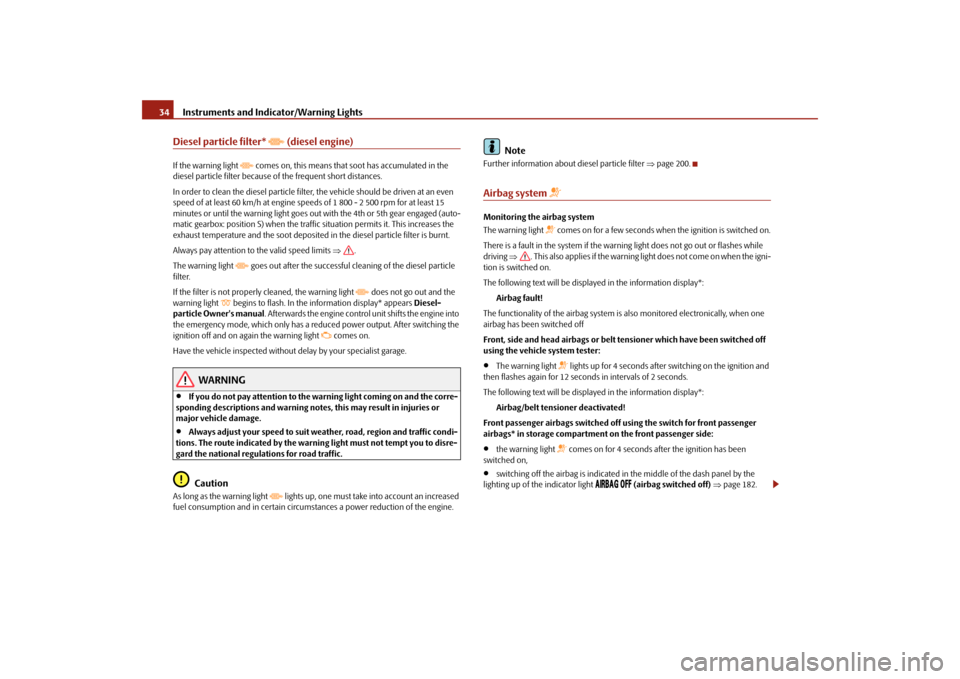
Instruments and Indicator/Warning Lights
34
Diesel particle filter*
(diesel engine)
If the warning light
comes on, this means that soot has accumulated in the
diesel particle filter because of the frequent short distances. In order to clean the diesel particle filter,
the vehicle should be
driven at an even
speed of at least 60 km/h at engine speeds of 1 800 - 2 500 rpm for at least 15 minutes or until the warning light goes ou
t with the 4th or 5th gear engaged (auto-
matic gearbox: position S) when the traffi
c situation permits it. This increases the
exhaust temperature and the soot deposited in the diesel particle filter is burnt. Always pay attention to the valid speed limits
⇒
.
The warning light
goes out after the successful cleaning of the diesel particle
filter. If the filter is not properly
cleaned, the warning light
does not go out and the
warning light
begins to flash. In the information display* appears
Diesel-
particle Owner's manual
. Afterwards the engine control unit shifts the engine into
the emergency mode, which only has a reduced power output. After switching the ignition off and on again the warning light
comes on.
Have the vehicle inspected without delay by your specialist garage.
WARNING
•
If you do not pay attention to the warning light coming on and the corre-
sponding descriptions and warning notes, this may result in injuries or major vehicle damage.•
Always adjust your speed to suit weather, road, region and traffic condi-
tions. The route indicated by the warning light must not tempt you to disre- gard the national regulations for road traffic.
Caution
As long as the warning light
lights up, one must take into account an increased
fuel consumption and in certain circumst
ances a power reduction of the engine.
Note
Further information about diesel particle filter
⇒page 200.
Airbag system
Monitoring the airbag system The warning light
comes on for a few seconds when the ignition is switched on.
There is a fault in the system if the warning light does not go out or flashes while driving
⇒
. This also applies if the warning light does not come on when the igni-
tion is switched on. The following text will be displayed in the information display*:
Airbag fault!
The functionality of the airbag system is
also monitored electronically, when one
airbag has been switched off Front, side and head airbags or belt
tensioner which have been switched off
using the vehicle system tester:•
The warning light
lights up for 4 seconds after switching on the ignition and
then flashes again for 12 seconds in intervals of 2 seconds. The following text will be displayed in the information display*:
Airbag/belt tensio
ner deactivated!
Front passenger airbags switched off
using the switch for front passenger
airbags* in storage compartment on the front passenger side:•
the warning light
comes on for 4 seconds after the ignition has been
switched on,•
switching off the airbag is indicated in
the middle of the dash panel by the
lighting up of the indicator light
(airbag switched off)
⇒page 182.
se0.1.book Page 34 Friday, April 10, 2009 3:19 PM
Page 36 of 304
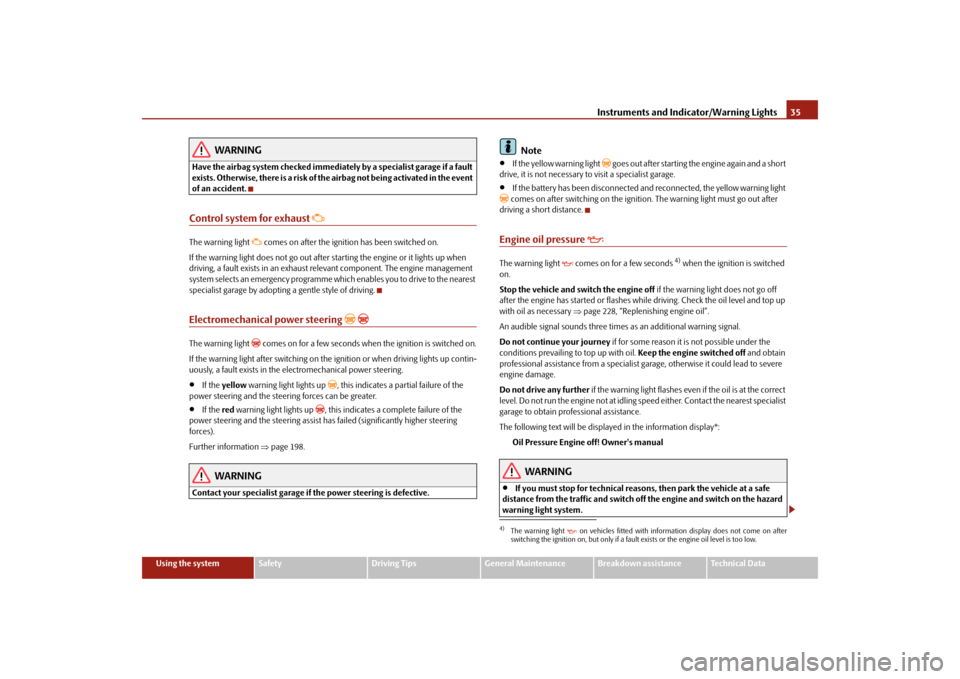
Instruments and Indicator/Warning Lights
35
Using the system
Safety
Driving Tips
General Maintenance
Breakdown assistance
Technical Data
WARNING
Have the airbag system checked immediat
ely by a specialist garage if a fault
exists. Otherwise, there is a risk of th
e airbag not being activated in the event
of an accident.Control system for exhaust
The warning light
comes on after the ignition has been switched on.
If the warning light does not go out after starting the engine or it lights up when driving, a fault exists in
an exhaust relevant componen
t. The engine management
system selects an emergency programme which enables you to drive to the nearest specialist garage by adopting a gentle style of driving.Electromechanical power steering
The warning light
comes on for a few seconds when the ignition is switched on.
If the warning light after switching on the ig
nition or when driving lights up contin-
uously, a fault exists in the el
ectromechanical power steering.
•
If the
yellow
warning light lights up
, this indicates a partial failure of the
power steering and the steering forces can be greater.•
If the
red
warning light lights up
, this indicates a complete failure of the
power steering and the steering assist has failed (significantly higher steering forces). Further information
⇒page 198.
WARNING
Contact your specialist garage if
the power steering is defective.
Note
•
If the yellow warning light
goes out after starting the engine again and a short
drive, it is not necessary to visit a specialist garage.•
If the battery has been disconnected and reconnected, the yellow warning light
comes on after switching on the ignition. The warning light must go out after driving a short distance.Engine oil pressure
The warning light
comes on for a few seconds
4) when the ignition is switched
on. Stop the vehicle and sw
itch the engine off
if the warning light does not go off
after the engine has started or flashes while driving. Check the oil level and top up with oil as necessary
⇒page 228, “Replenishing engine oil”.
An audible signal sounds three times as an additional warning signal.Do not continue your journey
if for some reason it is not possible under the
conditions prevailing
to top up with oil.
Keep the engine switched off
and obtain
professional assistance from a specialist garage, otherwise it could lead to severe engine damage. Do not drive any further
if the warning light flashes even if the oil is at the correct
level. Do not run the engine not at idling
speed either. Contact the nearest specialist
garage to obtain professional assistance. The following text will be displayed in the information display*:
Oil Pressure Engine off! Owner's manual
WARNING
•
If you must stop for technical reasons, then park the vehicle at a safe
distance from the traffic and switch off the engine and switch on the hazard warning light system.4)The warning light
on vehicles fitted with information display does not come on after
switching the ignition on, but only if a fault exists or the engine oil level is too low.
se0.1.book Page 35 Friday, April 10, 2009 3:19 PM
Page 37 of 304
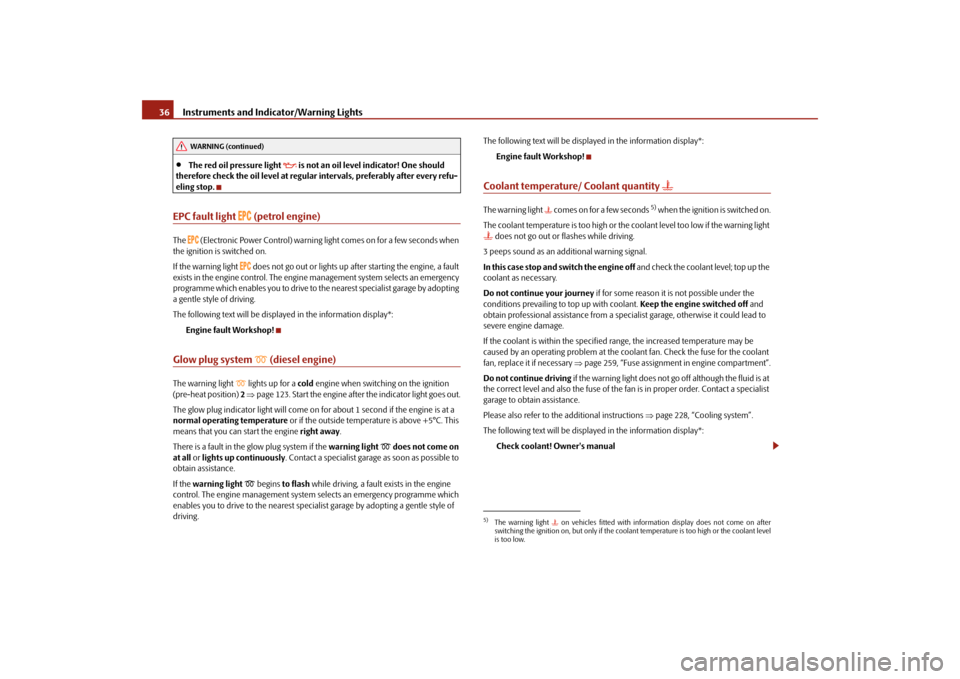
Instruments and Indicator/Warning Lights
36
•
The red oil pressure light
is not an oil level indicator! One should
therefore check the oil level at regular
intervals, preferably after every refu-
eling stop.EPC fault light
(petrol engine)
The
(Electronic Power Control) warning light comes on for a few seconds when
the ignition is switched on. If the warning light
does not go out or lights up
after starting th
e engine, a fault
exists in the engine control. The engine management system selects an emergency programme which enables you to drive to the nearest specialist garage by adopting a gentle style of driving. The following text will be displayed in the information display*:
Engine fault Workshop!
Glow plug system
(diesel engine)
The warning light
lights up for a
cold
engine when switching on the ignition
(pre-heat position)
2 ⇒page 123. Start the engine after the indicator light goes out.
The glow plug indicator light will come on for about 1 second if the engine is at a normal operating temperature
or if the outside temperature is above +5°C. This
means that you can start the engine
right away
.
There is a fault in the glow plug system if the
warning light
does not come on
at all
or lights up continuously
. Contact a specialist garage
as soon as possible to
obtain assistance. If the
warning light
begins
to flash
while driving, a fault exists in the engine
control. The engine management system
selects an emergency programme which
enables you to drive to the nearest specialist garage by adopting a gentle style of driving.
The following text will be displayed in the information display*:
Engine fault Workshop!
Coolant temperature/ Coolant quantity
The warning light
comes on for a few seconds
5) w h e n t h e i g n i t i o n i s s w i tc h e d o n .
The coolant temperature is too high or the coolant level too low if the warning light does not go out or flashes while driving.3 peeps sound as an additional warning signal.In this case stop and switch the engine off
and check the coolant level; top up the
coolant as necessary. Do not continue your journey
if for some reason it
is not possible under the
conditions prevailing to
top up with coolant.
Keep the engine switched off
and
obtain professional assistance from a specialist garage, otherwise it could lead to severe engine damage. If the coolant is within the specified range, the increased temperature may be caused by an operating problem at the coolant fan. Check the fuse for the coolant fan, replace it if necessary
⇒page 259, “Fuse assignment in engine compartment”.
Do not continue driving
if the warning light does not go off although the fluid is at
the correct level and also the fuse of the fan is in proper order. Contact a specialist garage to obtain assistance. Please also refer to the additional instructions
⇒page 228, “Cooling system”.
The following text will be displayed in the information display*:
Check coolant! Owner's manual
WARNING (continued)
5)The warning light
on vehicles fitted with information display does not come on after
switching the ignition on, but only if the coola
nt temperature is too high or the coolant level
is too low.
se0.1.book Page 36 Friday, April 10, 2009 3:19 PM
Page 38 of 304
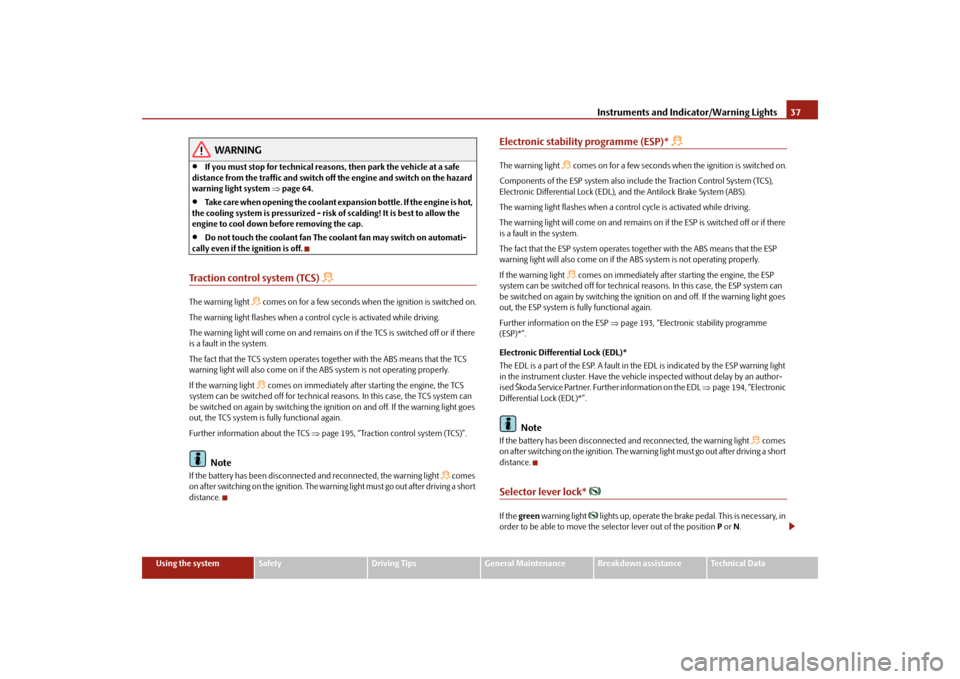
Instruments and Indicator/Warning Lights
37
Using the system
Safety
Driving Tips
General Maintenance
Breakdown assistance
Technical Data
WARNING
•
If you must stop for technical reasons, then park the vehicle at a safe
distance from the traffic
and switch off the engine and switch on the hazard
warning light system
⇒page 64.
•
Take care when opening the coolant expa
nsion bottle. If the engine is hot,
the cooling system is pressurized - risk of scalding! It is best to allow the engine to cool down before removing the cap.•
Do not touch the coolant fan The coolant fan may switch on automati-
cally even if the ignition is off.Traction control system (TCS)
The warning light
comes on for a few seconds when the ignition is switched on.
The warning light flashes when a cont
rol cycle is activated while driving.
The warning light will come on and remains on
if the TCS is switched off or if there
is a fault in the system. The fact that the TCS system operates together with the ABS means that the TCS warning light will also come on if the
ABS system is not operating properly.
If the warning light
comes on immediately after starting the engine, the TCS
system can be switched off for technical
reasons. In this case, the TCS system can
be switched on again by switching the ignition on and off. If the warning light goes out, the TCS system is fully functional again. Further information about the TCS
⇒page 195, “Traction control system (TCS)”.
Note
If the battery has been disconnected
and reconnected, the warning light
comes
on after switching on the ignition. The warn
ing light must go out after driving a short
distance.
Electronic stability programme (ESP)*
The warning light
comes on for a few seconds when
the ignition is switched on.
Components of the ESP system also incl
ude the Traction Control System (TCS),
Electronic Differential Lock (EDL),
and the Antilock Brake System (ABS).
The warning light flashes when a control cycle is activated while driving.The warning light will come on and remains on
if the ESP is switched off or if there
is a fault in the system. The fact that the ESP system operates together with the ABS means that the ESP warning light will also come on if the ABS system is not operating properly. If the warning light
comes on immediately after starting the engine, the ESP
system can be switched off for technical
reasons. In this case, the ESP system can
be switched on again by swit
ching the ignition on and off. If the warning light goes
out, the ESP system is fully functional again. Further information on the ESP
⇒page 193, “Electronic
stability programme
(ESP)*”. Electronic Differential Lock (EDL)* The EDL is a part of the ESP. A fault in the EDL is indicated by the ESP warning light in the instrument cluster. Have the vehicle inspected without delay by an author- ised Škoda Service Partner. Further information on the EDL
⇒page 194, “Electronic
Differential Lock (EDL)*”.
Note
If the battery has been disconnected
and reconnected, the warning light
comes
on after switching on the ignition. The warn
ing light must go out after driving a short
distance.Selector lever lock*
If the
green
warning light
lights up, operate the brake pedal. This is necessary, in
order to be able to move the selector lever out of the position
P or N.
se0.1.book Page 37 Friday, April 10, 2009 3:19 PM
Page 39 of 304
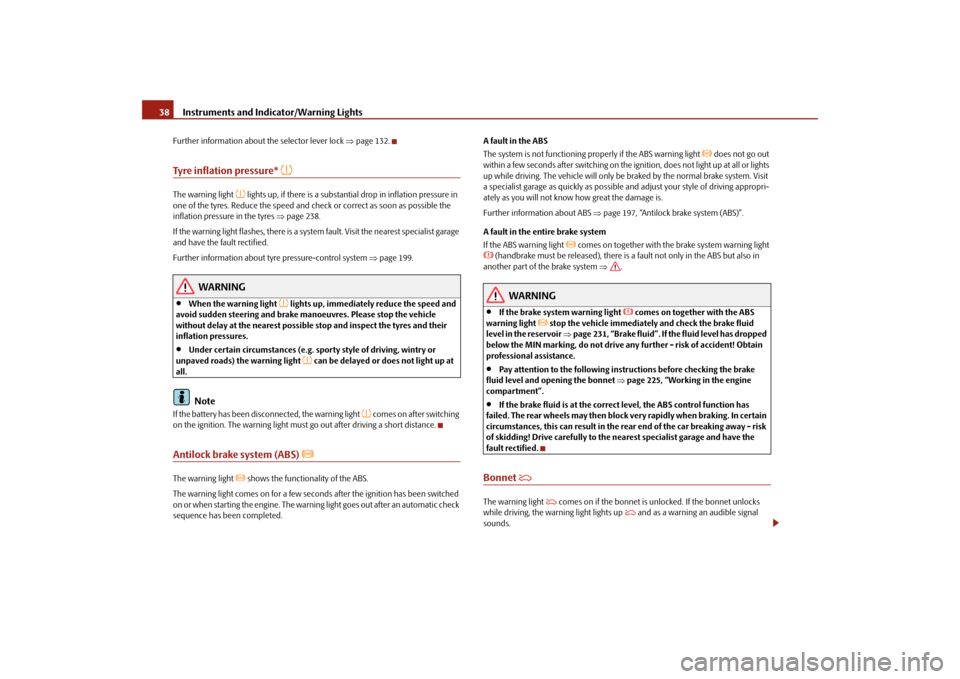
Instruments and Indicator/Warning Lights
38
Further information about the selector lever lock
⇒page 132.
Tyre inflation pressure*
The warning light
lights up, if there is a substantial drop in inflation pressure in
one of the tyres. Reduce the speed and check or correct as soon as possible the inflation pressure in the tyres
⇒page 238.
If the warning light flashes, there is a system fault. Visit the nearest specialist garage and have the fault rectified. Further information about tyre pressure-control system
⇒page 199.
WARNING
•
When the warning light
lights up, immediately reduce the speed and
avoid sudden steering and brake mano
euvres. Please stop the vehicle
without delay at the nearest possible stop and inspect the tyres and their inflation pressures.•
Under certain circumstances (e.g. sporty style of driving, wintry or
unpaved roads) the warning light
can be delayed or does not light up at
all.
Note
If the battery has been disconnected, the warning light
comes on after switching
on the ignition. The warning light must
go out after driving a short distance.
Antilock brake system (ABS)
The warning light
shows the functionality of the ABS.
The warning light comes on for a few second
s after the ignition has been switched
on or when starting the engine. The warning light goes out after an automatic check sequence has been completed.
A fault in the ABS The system is not functioning properly if the ABS warning light
does not go out
within a few seconds after switching on the ig
nition, does not light up at all or lights
up while driving. The vehicle
will only be braked by th
e normal brake system. Visit
a specialist garage as quickly as possible and adjust your style of driving appropri-ately as you will not know how great the damage is. Further information about ABS
⇒page 197, “Antilock brake system (ABS)”.
A fault in the entire brake system If the ABS warning light
comes on together with the brake system warning light
(handbrake must be released), there is a fault not only in the ABS but also in another part of the brake system
⇒
.
WARNING
•
If the brake system warning light
comes on together with the ABS
warning light
stop the vehicle immediately and check the brake fluid
level in the reservoir
⇒page 231, “Brake fluid”. If the fluid level has dropped
below the MIN marking, do not drive any further - risk of accident! Obtain professional assistance.•
Pay attention to the following instru
ctions before checking the brake
fluid level and opening the bonnet
⇒page 225, “Working in the engine
compartment”.•
If the brake fluid is at the correct level, the ABS control function has
failed. The rear wheels may
then block very rapidly when braking. In certain
circumstances, this can result in the rear end of the car breaking away - risk of skidding! Drive carefully to the ne
arest specialist garage and have the
fault rectified.Bonnet
The warning light
comes on if the bonnet is unlocked. If the bonnet unlocks
while driving, the warning light lights up
and as a warning an audible signal
sounds.
se0.1.book Page 38 Friday, April 10, 2009 3:19 PM
Page 41 of 304
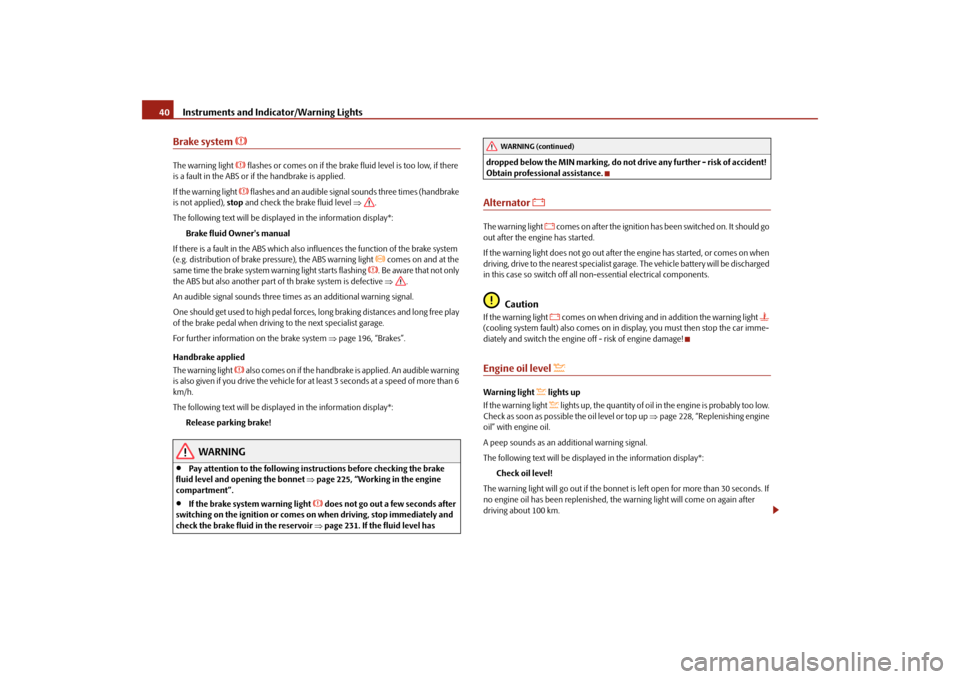
Instruments and Indicator/Warning Lights
40
Brake system
The warning light
flashes or comes on if the brake fluid level is too low, if there
is a fault in the ABS or if
the handbrake is applied.
If the warning light
flashes and an audible signal sounds three times (handbrake
is not applied),
stop
and check the brake fluid level
⇒
.
The following text will be displayed in the information display*:
Brake fluid Owner's manual
If there is a fault in the ABS which also in
fluences the function of the brake system
(e.g. distribution of brake pressure), the ABS warning light
comes on and at the
same time the brake system warning light starts flashing
. Be aware that not only
the ABS but also another part of th brake system is defective
⇒
.
An audible signal sounds three times as an additional warning signal.One should get used to high pedal forces, long braking distances and long free play of the brake pedal when driving to the next specialist garage. For further information on the brake system
⇒page 196, “Brakes”.
Handbrake applied The warning light
also comes on if the handbrake is applied. An audible warning
is also given if you drive the vehicle for at least 3 seconds at a speed of more than 6 km/h. The following text will be displayed in the information display*:
Release parking brake!
WARNING
•
Pay attention to the following instru
ctions before checking the brake
fluid level and opening the bonnet
⇒page 225, “Working in the engine
compartment”.•
If the brake system warning light
does not go out a few seconds after
switching on the ignition or comes on when driving, stop immediately and check the brake fluid in the reservoir
⇒page 231. If the fluid level has
dropped below the MIN marking, do not
drive any further - risk of accident!
Obtain professional assistance.Alternator
The warning light
comes on after the ignition has been switched on. It should go
out after the engine has started. If the warning light does not go out after
the engine has started, or comes on when
driving, drive to the nearest specialist garage. The vehicle battery will be discharged in this case so switch off all non-essential electrical components.
Caution
If the warning light
comes on when driving and in
addition the warning light
(cooling system fault) also comes on in display, you must then stop the car imme- diately and switch the engine off - risk of engine damage!Engine oil level
Warning light
lights up
If the warning light
lights up, the quantity of oil in the engine is probably too low.
Check as soon as possible the oil level or top up
⇒page 228, “Replenishing engine
oil” with engine oil. A peep sounds as an additional warning signal.The following text will be displayed in the information display*:
Check oil level!
The warning light will go out if the bonnet is
left open for more than 30 seconds. If
no engine oil has been replenished, the
warning light will come on again after
driving about 100 km.
WARNING (continued)
se0.1.book Page 40 Friday, April 10, 2009 3:19 PM
Page 42 of 304
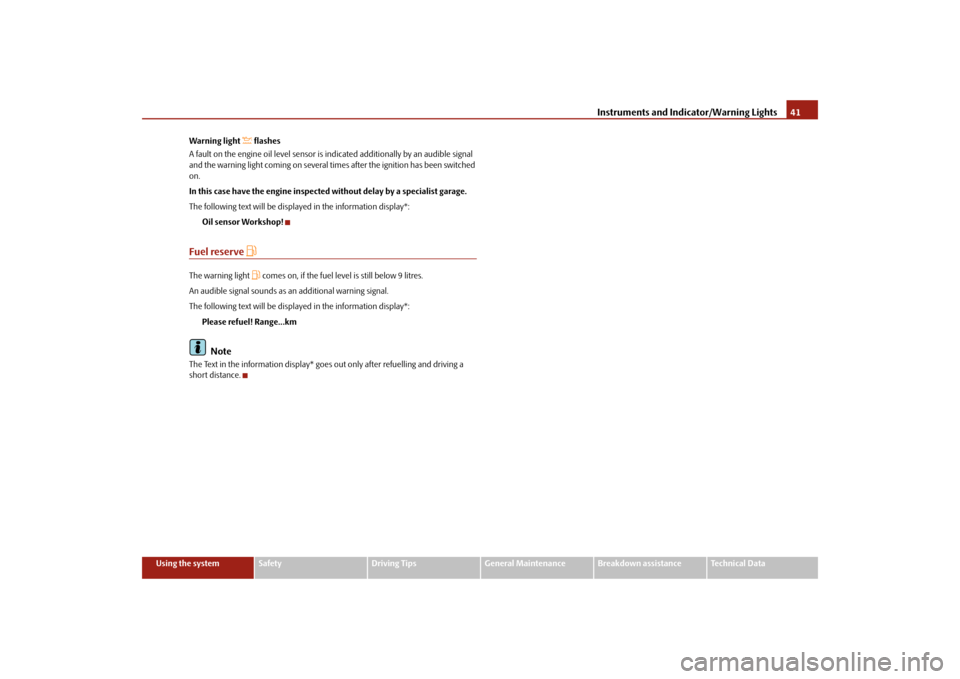
Instruments and Indicator/Warning Lights
41
Using the system
Safety
Driving Tips
General Maintenance
Breakdown assistance
Technical Data
Warning light
flashes
A fault on the engine oil level sensor is indicated additionally by an audible signal and the warning light coming on several times after the ignition has been switched on. In this case have the engine inspected without delay by a specialist garage.The following text will be displayed in the information display*:
Oil sensor Workshop!
Fuel reserve
The warning light
comes on, if the fuel level is still below 9 litres.
An audible signal sounds as an additional warning signal.The following text will be displayed in the information display*:
Please refuel! Range...kmNote
The Text in the information display* goes out only after refuelling and driving a short distance.
se0.1.book Page 41 Friday, April 10, 2009 3:19 PM
Page 43 of 304
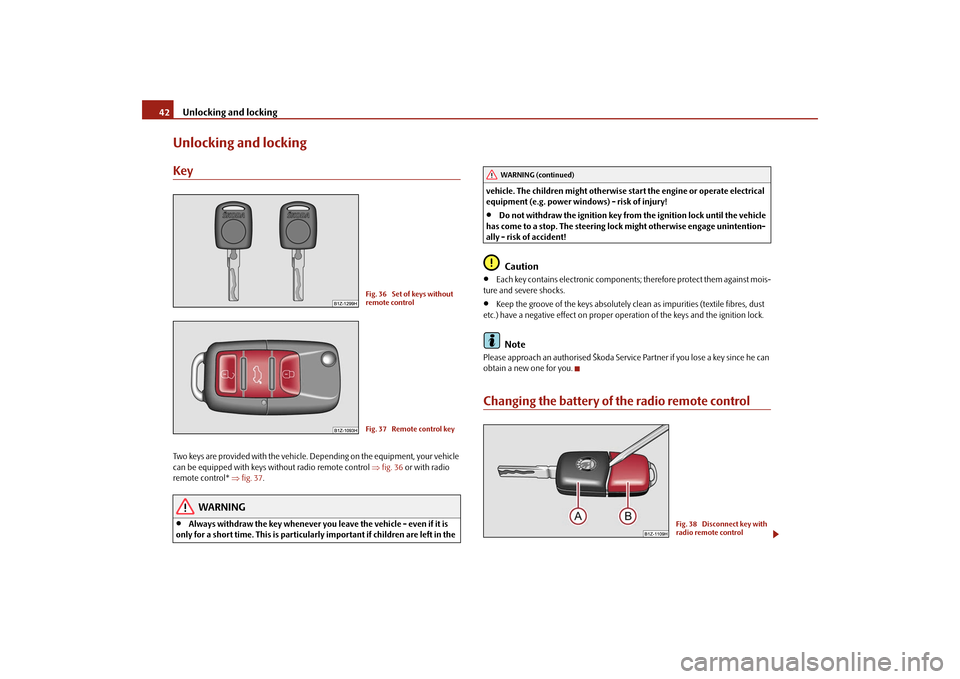
Unlocking and locking
42
Unlocking and lockingKeyTwo keys are provided with the vehicle. Depending on the equipment, your vehicle can be equipped with keys wi
thout radio remote control
⇒fig. 36
or with radio
remote control*
⇒fig. 37
.
WARNING
•
Always withdraw the key
whenever you leave the vehicle - even if it is
only for a short time. This is particularly important if children are left in the
vehicle. The children might otherwise st
art the engine or
operate electrical
equipment (e.g. power windows) - risk of injury!•
Do not withdraw the ignition key from the ignition lock until the vehicle
has come to a stop. The steering lock
might otherwise engage unintention-
ally - risk of accident!
Caution
•
Each key contains electronic components; therefore protect them against mois-
ture and severe shocks.•
Keep the groove of the keys absolutely cl
ean as impurities (t
extile fibres, dust
etc.) have a negative effect on proper op
eration of the keys and the ignition lock.
Note
Please approach an authorised Škoda Service Partner if you lose a key since he can obtain a new one for you.Changing the battery of the radio remote control
Fig. 36 Set of keys without remote controlFig. 37 Remote control key
WARNING (continued)
Fig. 38 Disconnect key with radio remote control
se0.1.book Page 42 Friday, April 10, 2009 3:19 PM
Page 44 of 304
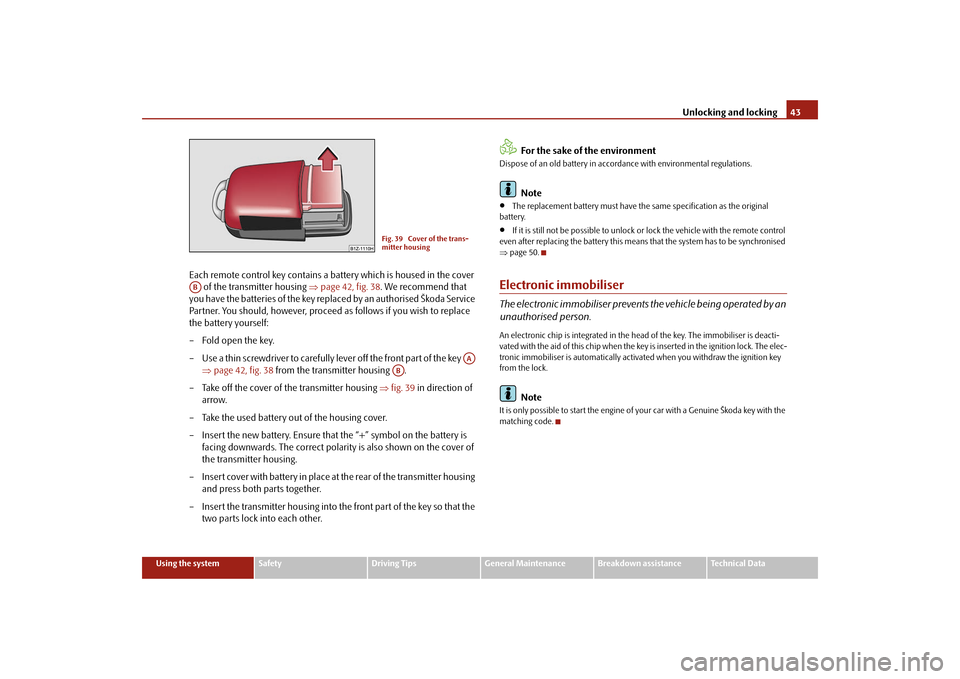
Unlocking and locking
43
Using the system
Safety
Driving Tips
General Maintenance
Breakdown assistance
Technical Data
Each remote control key contains a battery which is housed in the cover
of the transmitter housing
⇒
page 42, fig. 38
. We recommend that
you have the batteries of the key repl
aced by an authorised Škoda Service
Partner. You should, however, proceed as follows if you wish to replace the battery yourself: – Fold open the key. – Use a thin screwdriver to carefully
lever off the front part of the key
⇒
page 42, fig. 38
from the transmitter housing .
– Take off the cover of the transmitter housing
⇒
fig. 39
in direction of
arrow.
– Take the used battery out of the housing cover. – Insert the new battery. Ensure that the “+” symbol on the battery is
facing downwards. The correct polarity is also shown on the cover of the transmitter housing.
– Insert cover with battery in place at the rear of the transmitter housing
and press both parts together.
– Insert the transmitter housing into th
e front part of the key so that the
two parts lock into each other.
For the sake of the environment
Dispose of an old battery in accord
ance with environmental regulations.
Note
•
The replacement battery must have the same specification as the original
battery.•
If it is still not be possible to unlock or
lock the vehicle with the remote control
even after replacing the battery this means
that the system has to be synchronised
⇒ page 50.Electronic immobiliserThe electronic immobiliser prevents
the vehicle being operated by an
unauthorised person.An electronic chip is integrated in the he
ad of the key. The immobiliser is deacti-
vated with the aid of this chip when the key
is inserted in the ignition lock. The elec-
tronic immobiliser is automatically activa
ted when you withdraw the ignition key
from the lock.
Note
It is only possible to start the engine of
your car with a Genui
ne Škoda key with the
matching code.
Fig. 39 Cover of the trans- mitter housing
AB
AA
AB
se0.1.book Page 43 Friday, April 10, 2009 3:19 PM
Page 50 of 304
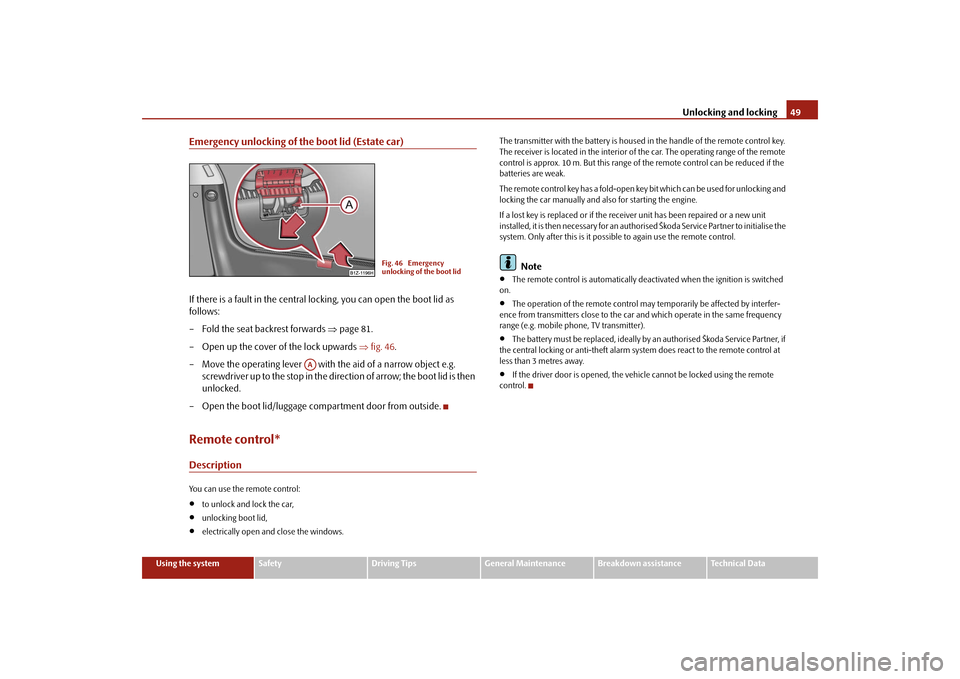
Unlocking and locking
49
Using the system
Safety
Driving Tips
General Maintenance
Breakdown assistance
Technical Data
Emergency unlocking of the boot lid (Estate car)If there is a fault in the central lo
cking, you can open the boot lid as
follows: – Fold the seat backrest forwards
⇒
page 81.
– Open up the cover of the lock upwards
⇒
fig. 46
.
– Move the operating lever with th
e aid of a narrow object e.g.
screwdriver up to the stop in the direction of arrow; the boot lid is then unlocked.
– Open the boot lid/luggage compartment door from outside.Remote control*DescriptionYou can use the remote control:•
to unlock and lock the car,
•
unlocking boot lid,
•
electrically open and close the windows.
The transmitter with the battery is housed in the handle of the remote control key. The receiver is located in the interior of
the car. The operating range of the remote
control is approx. 10 m. But this range of
the remote control can be reduced if the
batteries are weak. The remote control key has a fold-open key
bit which can be used for unlocking and
locking the car manually and also for starting the engine. If a lost key is replaced or if the receiv
er unit has been repaired or a new unit
installed, it is then necessary for an authorised Škoda Service Partner to initialise the system. Only after this is it possib
le to again use the remote control.
Note
•
The remote control is automatically deac
tivated when the ignition is switched
on.•
The operation of the remote control may temporarily be affected by interfer-
ence from transmitters close to the car and which operate in the same frequency range (e.g. mobile phone, TV transmitter).•
The battery must be replaced, ideally by
an authorised Škoda Service Partner, if
the central locking or anti-theft alarm system does react to the remote control at less than 3 metres away.•
If the driver door is opened, the vehicle cannot be locked using the remote
control.
Fig. 46 Emergency unlocking of the boot lid
AA
se0.1.book Page 49 Friday, April 10, 2009 3:19 PM